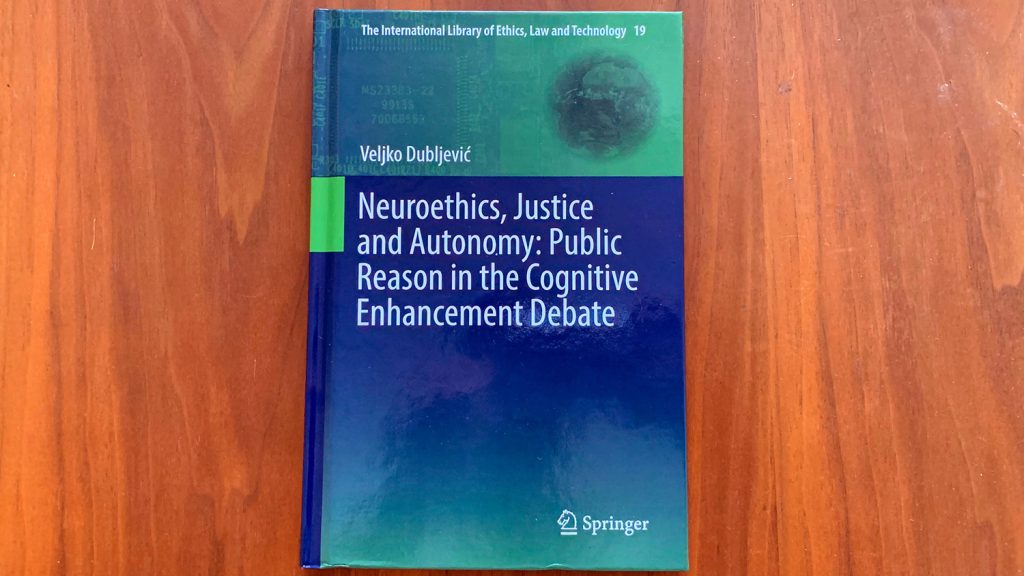The Ethics and Challenges Surrounding Neuroenhancement

From drugs to electronic implants, researchers are actively working on the development of new technologies aimed at improving an individual’s cognitive abilities, motor skills and other attributes. We’re not talking about helping people with health problems; we’re talking about enhancing the abilities of healthy people. And this raises a lot of questions.
Who should have access to these technologies? Do they give some people an unfair advantage? How do we address concerns about side effects? And who is responsible for answering these questions?
Some of these technologies have already made their way from science fiction to science fact, but there has been little debate about how to address these fundamental questions in terms of evidence-guided policies. A new book from Veljko Dubljević hopes to advance the conversation.
The book, Neuroethics, Justice and Autonomy: Public Reason in the Cognitive Enhancement Debate, focuses on ethical and regulatory questions pertaining to these cognitive neuroenhancement technologies, and argues for a more robust framework of laws and regulations governing their use.
We recently had an opportunity to talk with Dubljević, an assistant professor of philosophy at NC State, about the work.

The Abstract: The book looks at a number of cases of existing, or emerging, “cognitive neuroenhancement technologies.” Can you explain what that term means? What are some examples?
Veljko Dubljević: Cognitive neuroenhancement technologies are either pharmacological or electromagnetic tools. They are used as either “study aids” or “gadgets” to “overclock” the brain and supposedly provide increases in cognitive performance, either in terms of an increase of performance level or endurance at the same performance level despite the effects of fatigue.
For example, students often take Adderall, which is a form of amphetamine, to be able to study longer, whereas some athletes are using transcranial direct current stimulation to boost focus and skill acquisition, and the latter practice is undetectable by drug tests.
TA: What sort of ethical questions are raised by cognitive neuroenhancement technologies?
Dubljević: Safety is the most important issue, but questions of fairness (both in terms of access and cheating in exams and contests) and personal freedom (in terms of not being subjected to undue pressures to keep up with others) are very important and form the bases of the book.
TA: You take a “political neuroethics approach” to these technologies. What does that mean, and why is it relevant here?
Dubljević: There are many speculative approaches to the neuroethics of technology as well as discordant views on how neuroscience renders our freedom obsolete. Thus, the book champions the political approach to neuroethics, which is geared toward identifying the current social problems that are caused or exacerbated by neuroenhancement technologies and analyzing policy proposals in terms of their potential to successfully tackle those problems.
TA: You argue that laws and regulations are needed to govern these technologies. I know that you wrote an entire book about this, but could you provide a succinct explanation of why these things should be regulated?
Dubljević: The first issue is the potential for widespread use in a hyper-competitive environment. Research suggests that 34% of college students admit using pharmacological study aids to increase cognition. Users are usually not informed about the nature of pharmacological agents they are using and assume that they are safe and not addictive.
The second is the potential for social pressure to use potentially unsafe technologies, stemming from the desire to be competitive at all costs. A 2008 survey reported that most researchers would be opposed to providing such pharmacological agents to their children, but if the children of others were using “study aids” then they would give stimulants to their children as well.
Finally, there is a marketing push for newer neuroenhancement technologies, such as neurostimulation devices, and a lack of adequate regulation (e.g., if the producers claim that neurostimulation devices are not “medical devices,” the FDA has no jurisdiction). The problem is that the producers claim that neurostimulation is safe and effective, and it is – but only in controlled laboratory settings with trained professionals. Meanwhile, the marketing push is targeting untrained individuals, such as young adults interested in “neurogaming.”
TA: How do you think governments could, or should, balance the wants and needs of constituents who embrace these enhancements versus those who oppose them?
Dubljević: Governments should be neutral toward one’s preference to use or not, as long as the use is regulated in a way that ensures the technology is reasonably safe. Now, new technologies may cause additional strain on the society’s resources, especially when untrained individuals are encouraged by online sources to try out “cool new stuff.” Thus, making sure that users are well informed, tracking any adverse effects and generating funds (e.g., via taxation or fees) to address related social problems is crucial.
TA: What makes this book especially timely? Or, to put it another way, why did you write this book now?
Dubljević: Many of these so-called “study aids” are stimulants, and the stimulant use epidemic as experienced on university campuses and elsewhere in the U.S. has largely been overshadowed by the opioid epidemic. “Study aid” drugs are not deadly, but they are very addictive, and unless this is on the policy radar of our society (and decision makers), more and more people will be adversely impacted.
Additionally, neurostimulation devices are on the rise in forms of: 1) unregulated products, 2) “enhancement services” being provided by untrained individuals with questionable motives and even 3) unsafe jury-rigged “do-it-yourself” gadgets.
Hopefully, this book will encourage discussion and debate, and move us closer – as a society – to addressing these challenges in a way that addresses both personal choice and public safety.
This post was originally published in NC State News.


